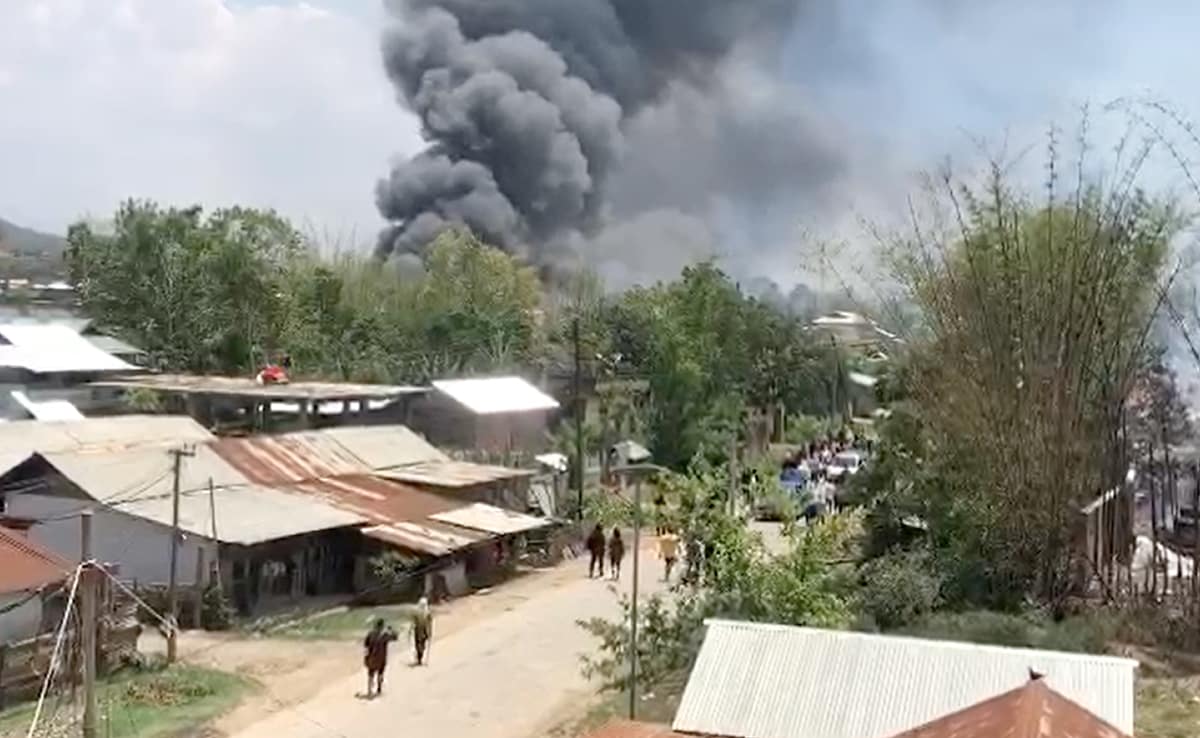The ethnic violence in Manipur is far from over, four months since it started. Reports of gunfights and deaths come almost every day. The security forces have set up safe zones, dividing areas where the valley-majority Meiteis and the hill-majority Kukis live.
What started as a protest by the Chin-Kuki tribes against the Meiteis' demand for inclusion under the Scheduled Tribes (ST) category has now changed into a demand by the Kukis for a "separate administration", whatever that means.
Why is it taking so long for the violence in Manipur to completely stop?
There could be five major reasons behind this.
Narcoterrorism
First, narcoterrorism and drug cartels are believed to be the driving force behind the Manipur crisis. Worldometer, the real-time statistics website that shot to fame during the COVID-19 pandemic, reported that drug trafficking, poppy cultivation and heroin business are estimated to be worth $110 billion globally.
India is located right between the top two biggest opium producers - Afghanistan, and the 'Golden Triangle' (Myanmar, Thailand and Laos). India's western border is well protected due to the active threat from Pakistan, but the eastern border with Myanmar remains largely unprotected as of date, making it the preferred route for drug cartels to move their 'product'.
Eastern Manipur's five districts share a 400-km border with Myanmar and less than 10 per cent of its international border with Myanmar is fenced, leaving the region wide open for drug smuggling. The total length of the India-Myanmar border is 1,600 km.
Poppy farms in Myanmar's Chin State's northern tip are just 60 km from Manipur's border town Moreh
There has been no alarming reason to expedite border-fencing, Myanmar being a friendly nation. But India's insurgency hub is also in this very region. So the question is, have we taken this lightly?
The shifting of the 'Golden Triangle' is well-documented with large-scale opium cultivation mushrooming in Manipur. Media reports have indicated at the direct involvement of Myanmar drug cartels. Over 18,000 acres of opium cultivation have been destroyed, a majority of which were in Chin-Kuki dominated areas.
Manipur's N Biren Singh government has in the past five years arrested over a thousand people in drugs cases following Prime Minister Narendra Modi's zero-tolerance to drugs policy. All these factors strengthen the allegation that narcotics is one of the main reasons behind the Manipur violence.
Instability In Myanmar
Second, the instability in neighbouring Myanmar where a military junta government is running the show has forced many of its citizens to flee to India. Armed rebellion, junta crackdowns and airstrikes on anti-junta forces are happening in Myanmar.
A United Nations report on March 6 this year - nearly two months before ethnic clashes broke out in Manipur - estimated Myanmar's internally displaced people at 17 lakh, of which 10.8 lakh were refugees and asylum-seekers. The 16-km 'free movement region' policy between India and Myanmar also eases entry of refugees into Manipur via the border trading town of Moreh. Chin-Kuki-Zo insurgents in Myanmar's western region bordering India are present predominantly in Manipur.
India is not a signatory to the Refugee Convention, 1951, and its 1967 protocol, yet Mizoram has been openly welcoming Myanmar refugees, up to 40,000 of them, according to the state home department data. Mizoram also registers them formally as "refugees", who may be deported later.
Manipur has said narcoterrorists and illegal Myanmar immigrants are behind the ethnic clashes
In neighbouring Manipur, the government has taken some steps to provide humanitarian help to the refugees whose actual number is yet to be ascertained. But the Chin-Kuki-Zo community allegedly do not ascribe refugee status to those who fled from Myanmar as they belong to the same ethnic groups, which the Meiteis allege shows ethnicity being given preference over nationality. Due to this, those seeking asylum prefer Manipur, for they would not be labelled as refugees and denied the same support that Indian citizens get. Many Myanmar citizens having fake Aadhaar and other documents have been arrested in Manipur.
Colonial Divide And Rule Lingering Effects
Third, a master stroke by the British that enabled them to control people was the zamindari system, a form of 'divide and rule'. Under the pretext of protecting the Manipur kingdom from Burma, the British started resettling Chin-Kuki-Zo people in the southern part of Manipur and introduced the feudal system, particularly chieftainship.
After the British left, India passed the Zamindari Abolition Act, 1951, and ended the zamindari system, but in Manipur the Chin-Kuki-Zo tribes still practice it. Even the Chin-Kuki-Zo dominated state Mizoram scrapped chieftainship.
The chiefs in Chin-Kuki-Zo villages in Manipur are the sole leaders of their settlements and own entire villages.
The feudal system follows nepotism and autocracy - when the current chief dies, only his son can become the next chief. The hunger for power and disloyalty among siblings have led to mushrooming of many villages in Manipur, particularly in the areas dominated by them. They have been accused of carrying out massive deforestation as the new villages are in the hills and forest areas. With Myanmar refugees and illegal immigrants pouring into Manipur, setting up new villages becomes easier as the newcomers could live as subjects.
A forest department beat office that was set on fire in Churachandpur (File)
The Times of India in a report on June 6, 2022, said Manipur has some 934 unrecognised villages. The Manipur government had been carrying out eviction drives to reclaim forest lands for the past few years, leading to violent protests at times. The forest department's offices in Churachandpur district were the first to be set on fire by miscreants before large-scale violence broke out on May 3 evening. One of the offices was misidentified as a "Kuki house" by the Editor's Guild of India in its recent report on the media's coverage of the Manipur violence. The guild later corrected the error.
Questionable Agreement With Insurgents
Fourth, Chin-Kuki-Zo insurgents from nearly 25 armed groups in Manipur have been under intense scrutiny for allegedly participating in the ethnic clashes despite signing a tripartite peace agreement in 2008 with the centre, the state government and the military, called the suspension of operations (SoO).
The South Asian Terrorism Portal, a repository of terrorism incidents, has recorded extortion from common people and commercial drivers on highways, kidnappings, and other illegal activities by the insurgents even after signing the SoO agreement. There are records of signed 'memos' sent by leaders of some insurgent groups, citing violation of SoO agreement ground rules by another group.
The army has been conducting surprise checks on 'suspension of operations' (SoO) camps in Manipur
In Churachandpur, the epicentre of the violence that started on May 3, visuals from a rally show people, allegedly from the SoO groups, in camouflage battledress carrying assault rifles. An insurgent group that had signed the SoO agreement had also made a call to end a two-month-long blockade of a National Highway. The effectiveness of the SoO agreement is questionable if the insurgent groups are carrying out illegal activities.
Inadequate Constitutional Protection
Fifth, the constitutional protection given to ethnic groups in India's north-east seems to be inadequate to cover today's realities. After all, it has been over 76 years since Independence. It cannot be denied the north-east saw slow growth compared with the rest of the nation, until development picked up in the past nine years. The people in the north-east are ethnically and culturally diverse, distinct with their own customs and practices.
All the major ethnic groups in every state in the north-east are protected by the Scheduled Castes and Scheduled Tribes (Prevention of Atrocities) Act, 1989. The Mizos in Mizoram; the Khasi, Jantia, and Garo in Meghalaya; Nagas in Nagaland, and major indigenous ethnic groups in Arunachal Pradesh, Assam, Tripura and Sikkim are protected by this important law.
But in Manipur, only the Nagas and Kukis are protected. The Meiteis, who are also a major ethnic group in Manipur, are not protected.
This exclusion is a clear case of discrimination against the Meitei community. Without protection under the law, the Meitei community is left with access to a mere 6-8 per cent of the total land area of the state, which is confined to the valley region. This is the actual area where Meiteis can live, own land, and call it their home, while the other 92-94 per cent of the state is denied to them.
The recognised tribes can, however, own land and live in the valley.
Meiteis cannot buy land in the hill areas, while the Kuki tribes can own land and property in the valley areas
The reservation system, which is 31 per cent for Scheduled Tribes (ST) in Manipur, has not been in favour of the Meiteis. With similar opportunities being provided, the representation of the Meitei community in jobs and education has been declining. Data from the last two results of the Manipur Public Service Commission shows many ST candidates from the Chin-Kuki-Zo tribes have been selected on merit plus the 31 per cent reservation.
Many from the Meitei community have migrated to other cities in the struggle to support themselves and their families due to lack of opportunity and support in their own state.
The early British Census reports in 1901 recorded the Meiteis as "tribes". Shockingly, this disappeared from the same list after Independence. There has been no explanation and consensus on how the vanishing act happened.
Each of these five factors are interconnected, so one solution may not fit all. What is certain is decisive action is the only way forward. At the very least, the Meiteis need constitutional protection against all these factors and forces.
They are not asking for extra cushioning, but to be treated and protected just as other tribes in the north-east.
(Debanish Achom is Editor, News, at NDTV)
Disclaimer: These are the personal opinions of the author.






Leave a Reply